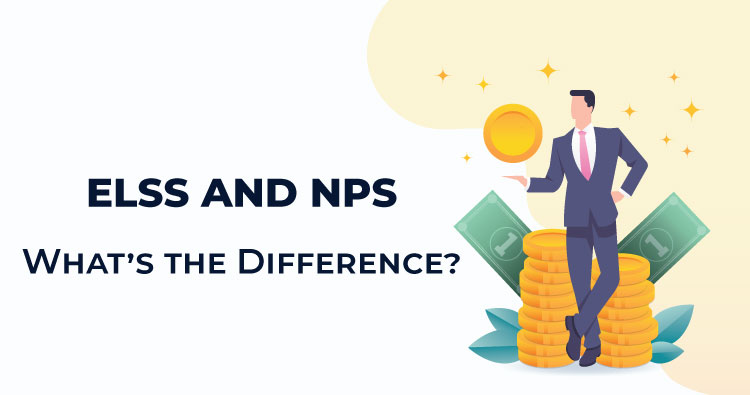- +91 9898200242
-


Saving on taxes is a crucial aspect of financial planning and wealth creation. There are various avenues available for individuals to invest in reducing their tax burden. For example, you can reduce your taxable income up to Rs by investing in tax-saving investment options under Section 80C. 1.5 lakhs. This article compares two popular schemes, NPS and ELSS, and discusses their differences.
The National Pension System or NPS is a voluntary initiative by the central government to provide social security. The plan can be used as a long-term investment vehicle for those with a long-term investment horizon. The Pension Fund Regulatory and Development Authority (PFRDA) and the Central Government regulate the pension fund. Every employee is eligible to invest in NPS, including those in the private, public, and unorganized sectors.
The Equity Linked Savings Scheme (ELSS) is an open-ended mutual fund scheme that invests primarily in equity and equity-related instruments and allows investors to save taxes. Investment in ELSS serves both to reduce taxes and create long-term wealth. The returns generated from this scheme are market-linked; therefore, they cannot be guaranteed. ELSS funds have become popular in recent years because they offer higher returns than traditional tax-saving instruments. This scheme is better suited to investors with a long-term investment perspective.
The following is a complete comparison of NPS vs ELSS mutual funds, including the parameters differentiating between the two.
An NPS investment remains locked in until at least 60 or retirement, whichever occurs first. Investors may also extend their NPS accounts until the age of 70. Investors can partially withdraw a maximum of 25% for very specific reasons, but they must complete at least ten years. Thus, investors cannot redeem their money before they complete ten years or reach 60 years.
On the other hand, ELSS has the shortest lock-in period of three years.
NPS investors have the option to choose between auto and active investment, where the portfolio is segregated into different asset classes, such as equity, corporate debt, government securities, and alternative investment funds in different proportions. However, the maximum equity exposure that an investor can take through the NPS investment option is 75%.
ELSS funds invest at least 80% of their assets in equity and equity-related instruments.
We have seen that compared to NPS investment, ELSS funds have higher equity exposure. As a result, ELSS investment carries a higher risk. Professional fund managers actively manage these funds to provide attractive returns while managing the risks.
NPS has a management fee of 0.1%, making it one of the investment options with the lowest costs. In contrast, asset management companies charge an expense ratio of between 0.5% and 1.50%, which is much higher than the cost of managing NPS.
ELSS mutual funds are more transparent than NPS since they publicly disclose their asset allocation via factsheets on their websites every month. Using this information, investors can compare the holdings of different funds across different sectors. In NPS, however, asset allocation is not transparent.
Investors investing in NPS are eligible for a higher tax deduction of up to Rs 2 lakh under Sec 80C, i.e. Rs. 1.50 lakh under Sec 80CCD(1) and Rs. 50,000 under Sec 80CCD (1B).
ELSS investors can get tax benefits on investments up to Rs.1.5 lakh. In addition, the NPS has the advantage that subscribers can withdraw up to 60% of their total corpus as a lump sum without paying any tax. With a balance of 40%, you need to buy an annuity plan. However, the annuities will attract tax.
Both investment options offer tax benefits. However, the tax benefits of NPS funds are greater than those of ELSS funds. In ELSS funds, long-term gains above Rs. 1 lakh are taxed at 10%.
Conclusion:
Before investing in any scheme, write your financial goals and objectives. Next, decide how long you will invest. Finally, you need to align your financial goals with your financial objectives. Afterward, you can choose investments that suit your needs.
You may achieve long-term goals with ELSS funds. ELSS funds also yield higher returns than NPS funds. However, they are riskier than NPS funds. In addition, ELSS funds differ from NPS funds as they have a low lock-in period of three years.
To learn more about NPS and ELSS, contact us.
This blog is purely for educational purposes and not to be treated as personal advice. Mutual fund investments are subject to market risks, read all scheme related documents carefully.




At WealthKare, we believe true wealth is not just about making money—it’s about managing it to bring freedom, peace, and joy into your life. Many people struggle financially, not due to a lack of effort, but because they weren’t taught how to manage their money. Our mission is to help families break free from financial stress and equip them with the tools and knowledge to build lasting financial security.
Corporate Office
A 506 Ratnakar Nine Square,
Keshavbaug, Vastrapur, Ahmedabad
Registered Office
First Floor, FF 3, Rajshri Avenue,
Shahibaug Dafnala Road, B/h Vasant Vihar
Tower, Ahmedabad, Gujarat, 380004
+91 9898200242
Copyright © wealthkare. All rights reserved. |